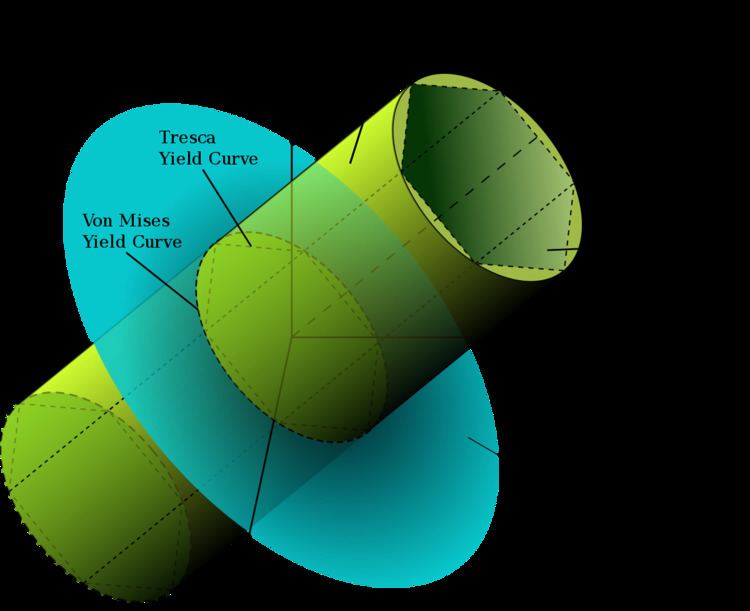 | ||
The von Mises yield criterion suggests that the yielding of materials begins when the second deviatoric stress invariant
Contents
- Mathematical formulation
- Reduced von Mises equation for different stress conditions
- Physical interpretation of the von Mises yield criterion
- Practical engineering usage of the von Mises yield criterion
- Comparison with Tresca yield criterion
- References
In materials science and engineering the von Mises yield criterion can be also formulated in terms of the von Mises stress or equivalent tensile stress,
Because the von Mises yield criterion is independent of the first stress invariant,
Although formulated by James Clerk Maxwell in 1865, it is generally attributed to Richard Edler von Mises (1913). Tytus Maksymilian Huber (1904), in a paper in Polish, anticipated to some extent this criterion. This criterion is also referred to as the Maxwell–Huber–Hencky–von Mises theory.
Mathematical formulation
Mathematically the von Mises yield criterion is expressed as:
where
where
or
Substituting
This equation defines the yield surface as a circular cylinder (See Figure) whose yield curve, or intersection with the deviatoric plane, is a circle with radius
Reduced von Mises equation for different stress conditions
The above equation can be reduced and reorganized for practical use in different loading scenarios.
In the case of uniaxial stress or simple tension,
which means the material starts to yield when
It is also convenient to define an Equivalent tensile stress or von Mises stress,
where
In this case, yielding occurs when the equivalent stress,
In the case of pure shear stress,
This means that, at the onset of yielding, the magnitude of the shear stress in pure shear is
In the case of plane stress,
This equation represents an ellipse in the plane
The following table summarizes von Mises yield criterion for the different stress conditions.
Notes:
Physical interpretation of the von Mises yield criterion
Hencky (1924) offered a physical interpretation of von Mises criterion suggesting that yielding begins when the elastic energy of distortion reaches a critical value. For this reason, the von Mises criterion is also known as the maximum distortion strain energy criterion. This comes from the relation between
In 1937 Arpad L. Nadai suggested that yielding begins when the octahedral shear stress reaches a critical value, i.e. the octahedral shear stress of the material at yield in simple tension. In this case, the von Mises yield criterion is also known as the maximum octahedral shear stress criterion in view of the direct proportionality that exists between
thus we have
Practical engineering usage of the von Mises yield criterion
Use of the von Mises Criterion as a failure theory is only exactly applicable when homogeneous material properties are equal to
Since no material will have this ratio precisely, in practice it is necessary to use engineering judgement to decide what failure theory is appropriate for a given material. Alternately, for use of the Tresca Theory, the same ratio is defined as 1/2.
The yield Margin of safety is written as
Although the given criterion is based on a yield phenomenon, extensive testing has shown that use of a "von Mises" stress is applicable at ultimate loading
Comparison with Tresca yield criterion
Also shown in the figure is Tresca's maximum shear stress criterion (dashed line). Observe that Tresca's yield surface is circumscribed by von Mises's. Therefore, it predicts plastic yielding already for stress states that are still elastic according to the von Mises criterion. As a model for plastic material behavior, Tresca's criterion is therefore more conservative, but not more accurate depending on the applicability for a given material.
